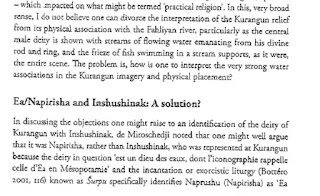Spouted silver bowl decorated with entwined serpents. Southeastern Iran Mid 3rd millennium BC. From Al-Sabah collection.
Why was this vessel decorated with entwined serpents? Here's what I think:
I already talked about this type of vessels in my post "Elamite water bull" about this Proto-Elamite silver figurine of a clothed anthropomophised kneeling bull...holding a spouted [water] vessel. c. 3000BC. Currently in the Met Museum...
My guess that this figure is either Enki (Sumerian god of sweet water) or Utu (Sumerian sun god)...Or their unnamed Elamite equivalent who possibly combines both of them in one...
They were both described as bulls. Why?
These are yearly charts of the water levels in Tigris and Euphrates. You can see that they both peak in Apr/May, Taurus, Bull...
BTW, Taurus here is The Old Taurus, the animal calendar marker for the beginning of the calving season of wild eurasian cattle...
This rise in water levels in Tigris and Euphrates is the result of the sun heating up of the mountains which are the source of the two great rivers: Anatolian highlands and the Zagros mountains...Which causes the snow to melt, which causes the rivers to swell...
Snowmelt, Zagros
Hence the humanoid bull holding a spouted water vessel...Which looks just like the vessel from the Al-Sabah collection...
I talked about another water carrier figurine from Iran in my post "Water carrier equid", about this "Spouted Anthropomorphic Vessel", Western Iran, circa 1000-650 BCE. Currently in Los Angeles County Museum of Art...
Here the anthropomorphised animal water carrier is not a bull but an equid, horse or a donkey. Why? Cause equid mating season, starts in Apr/May, right when the water discharge peaks in the rivers in Mesopotamia/Iran...
But why was the vessel from the Al-Sabah collection decorated with entwined serpents?
First, snake is a solar animal, pretty much a universal symbol of the sun's heat. Snakes follow sun everywhere. They are in our world when sun is in our world (day, summer) and in the underworld when the sun is in the underworld (night, winter)...I talked about this in many of my posts. For instance "Snake god from Hatra"...
And it is the sun's heat that melts the snow...
Second, snake mating season, when snakes intertwine, starts in Apr/May, the time of the peak snowmelt runoff in Iranian mountains, and the peak discharge of the rivers in the Tigris/Euphrates system...
Which is why in the Deliver Me from Evil: Mesopotamian Incantations, 2500-1500 BC, By Graham Cunningham, we can read that in the Earliest Sumerian texts, Enki, the god of sweet flowing water and the source of Tigris and Euphrates, was associated with poisonous snakes...
Hence Enki (Or at least Elamite equivalent of Enki) sitting on a snake throne....
And which is why I think the [water] vessel from the Al-Sabah collection is decorated with entwined serpents...
Great info can be found in this X thread by @dalaygiz
“Twenty different officiants are attested in connection with Napiriša. Their designations vary from simple šatin (4) and makuš (7) to (makuš) pirramadda (3) and (makuš) haturmakša; their names are all Iranian except for two.”
“Elsewhere, the same individuals are associated with a range of other sacrifices, including sacrifices for or at various mountains, for Adad, Auramazdā, Išpandaramattiš, and (the) Mišebaka.”
(‘The Heartland Pantheon’, Henkleman, pg 1229)
“The syllabic spellings of the name (AN na‐pír‐šá‐ra, AN na‐pír‐ir‐šá‐ir‐ra) follow the development riša > irša, “great,” suggesting that the name of the god was still understood as a compound (logographic spellings: AN dingir.gal MEŠ, AN gal MEŠ).”
The origins of Napiriša, attested since the early second millennium BCE, may lie in the eastern highlands of Elam. This may also account for his popularity in the PFA*.
The water‐giving god and his wife are shown here at the open‐air sanctuary of Kūrāngūn:
It’s majorly held for the figures above that they are Napiriša (or Napiriša‐Inšušinak) and his spouse Kiririša, the ‘Great Goddess’ of Liyan/Būšehr.
Also, Mesopotamians identified “Naprušu/Napriš” as their own Ea/Enki.
(‘The Heartland Pantheon’, Henkleman, pg 1228)
*Persepolis Fortification Tablets
This deity is attested for 26 times and given Iranian epithets.
Here’s the Kurangun relief, which depicts a horned Elamite deity seated upon a snake-coiled throne. 17th century BCE. It’s in Fars, Iran.
“He is seated on a throne formed by the body of a snake, coiled back upon itself over and over again, and he grasps the tail of the snake in his left hand. In his right he holds the divine rod and ring [my comment, he is not holding rod and ring, he is holding a cup, just like Enki/Ea] from which two streams of water flow [...]”
(D.T Potts, From Handaxe to Khan, 1990, pg.146)
You can read more here: The numinous and the immanent
"In terms of identification, he has been called Inshushinak, who was the patron of Susa anyways. Enki/Ea/Napirisha are mentioned as well; the author deduces that these names/figures are all in fact related, with the former being used as epithets, besides the shared identity"...
















No comments:
Post a Comment